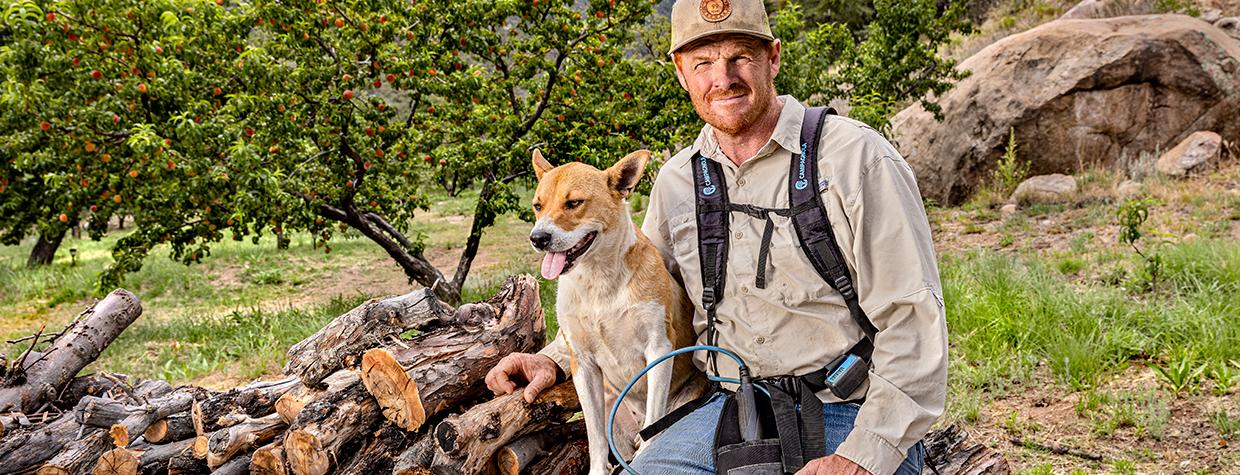There’s plenty of history at Angle Orchard, which is celebrating its centennial this year. And according to the descendants of Andrew Preston Angle and his wife, Viola — who began growing fruit in the foothills of Eastern Arizona’s Pinaleño Mountains in 1922 — it all started with a peach pit. As the story goes, sometime in the 1910s, someone passing through the area ate a peach and discarded the pit near Jacobson Creek, just off present-day State Route 366 (the Swift Trail). A peach seedling grew and bore fruit year after year, even in years when freezes affected peach crops in the Gila Valley below.
The Angles, who had come to Arizona from West Virginia, were homesteading in Artesia, a site at the base of the mountains that was named for its natural wells. They surmised that the peach tree was being protected from freezes by thermals, or currents of warm air. And after they got a 10-acre plot from the U.S. Forest Service via a 100-year lease, Angle Orchard was born.
Andrew Angle never got to see the literal fruits of his labor — he died of appendicitis in 1929, just as the fruit was starting to appear — but his sons took over the property, and it’s been in the family ever since. Paul Larson (pictured), one of the Angles’ great-grandsons, took over as owner in 2018, after his mother, Betty, was diagnosed with dementia. He says running the orchard is “part family tradition, part labor of love.” His cousin, Mike Millett, adds: “And he just doesn’t know any better.”
He’s joking. Sort of. The thermals do protect the orchard’s 15 or so varieties of peaches and 11 types of apples, from staples such as Fuji and Gala to lesser-knowns such as Arkansas Black. But first, the trees have to get planted in the hard, rocky ground. Millett recalls using dynamite to dig holes when he came here with his grandfather in the 1960s and ’70s. These days, planting takes up plenty of time, but so do pruning, thinning and watering, depending on the time of year. Larson manages the orchard with assistance from other family members.
On a warm April afternoon, Larson leads a tour of the orchard, which sits on a dusty gravel road that leads south from SR 366. Near the road is a building that dates to the 1950s and was used to store harvested fruit. Andrew Angle’s eldest son, Rome, ran water pipes under the floor to keep the building cool and also built a hydroelectric plant at the site. Another structure was used for the orchard’s canning operation — the family’s cabin once sat nearby, but it burned down in the ’60s.
There were plenty of obstacles over the years, as detailed in a 1979 story in the Arizona Daily Star. By then, Rome’s brother, Drew, had taken over the orchard and dealt with problems ranging from root rot and mildew to insect infestations. “I always wanted a challenge,” he said, “and this was the biggest one I’d had, right here.”
In some ways, things are easier today. Larson points out a pheromone-emitting lure in one of the fruit trees, which prevents moths from reproducing and relieves Larson from donning a hazmat suit to spray insecticides several times a year. Irrigation ditches, which Millett helped his grandfather line with cement, have been replaced by a network of pipes. And the fences around the orchard have been repaired, keeping hungry deer away — although white-nosed coatis and skunks still make regular appearances.
The 1979 Daily Star story noted that “eaters of Angle Orchard apples swear they are the best anywhere.” Indeed, the apples have been winning awards since at least 1931, when they took first and second prizes at a fair in Stillwater, Oklahoma. Today, the orchard ships fruit to Phoenix and Tucson, but the heart of the operation is its “U-pick” events, during which locals and other visitors can collect their own peaches and apples by the pound.
And there are plenty of options. Saturn peaches, a small, doughnut-shaped variety, are first to ripen, around the Fourth of July, and other peaches follow through early September. Apples ripen from August to October, with Galas and Elstars first up and Fujis and Granny Smiths coming later. Prospective pickers can check the orchard’s Facebook page for the latest information about U-pick events, and visitors are advised to take their own boxes and bags for fruit, along with appropriate footwear and plenty of water.
Larson says the Coronado National Forest, which surrounds the orchard, has been a good partner and recently improved the road to the property. And while another 100-year lease wasn’t possible this time around, Larson did renew the lease for an additional 10 years. As he surveys the family business, his pride is evident.
“The apples are popping,” he says. “We’ve got a pretty good crop going this year.”
NEAR SAFFORD
Angle Orchard, facebook.com/angleorchard

